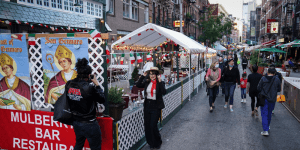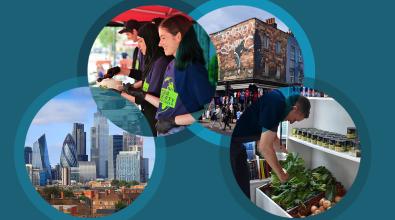4 keys to sustaining momentum for pandemic-era innovations

People are enjoying a closed off street, taking advantage of expanded outdoor dining and increased walking space. (Photo source: AP Photos/John Minchillo)
In the early days of the pandemic, city leaders innovated faster than ever before, launching COVID testing, food-delivery services, housing supports, and many other interventions aimed at lifting up residents when they needed help the most.
One idea that attracted a lot of attention was closing streets down to through traffic and giving the space over to pedestrians, bicyclists, restaurant seating, and more. These “slow streets” experiments created recreational space where it was in short supply, helped small businesses stay afloat, and opened the public’s eyes to new ways of using streets for other uses besides moving cars.
Now, as cities increasingly turn toward recovery, they’re looking at which of these innovations to sustain going forward—and slow streets have emerged as one to watch. Some cities, like San Diego, have largely pulled the plug on street closures, while others, like Denver, Houston, and Oakland, Calif., are extending theirs at least through 2022.
We spoke with several experts about these innovative programs and what forces are helping cities to keep momentum going for the long haul. Here’s four ingredients they identified.
Engage the community
While slow streets programs proved popular in many cities, there’s pressure to return to the way things used to be. “You’re going to hear the typical complaint that parking is more difficult,” says Jonathan Berk, a Boston-based consultant on placemaking and urban design. “But at the end of the day, it's a trade-off of ease of parking versus supporting local businesses, local jobs, and also just general livability of our communities.”
That’s why it’s so important to get deeply plugged into what communities think about these experiments, Berk adds. “It's about making sure you're casting a wide net and getting that broad brush of community feedback from across different types of residents in the area,” he said.
Alex Engel, spokesperson the National Association of City Transportation Officials (NACTO), says one of the challenges will be to ensure that each street is used in the way that most directly benefits the local community. “Every street is incredibly local and context-specific,” he says. “It requires careful planning and careful community consultation.”
The most effective engagement comes from partnering with community organizations to co-create projects from the beginning, says Jenny O’Connell, program manager at NACTO. “Expertise about the community is held within the community,” she says. “It's really important for cities to be working with people in the community.”
Be ready to pivot
Innovation requires iteration and being open to learning and adapting as you go. That’s been the case in Oakland, which was one of the first movers on Slow Streets during the pandemic, announcing plans to restrict traffic on 74 miles of streets in early April of 2020.
About 20 miles were in place when criticism began. In East Oakland, where many Black and Latinx residents live, some community groups said the Slow Streets program was not the first thing they needed from the city’s Department of Transportation. Rather, they wanted safer ways to cross the street, and vehicles to slow down, on busy arterial roads that remained open to traffic and were known pedestrian hazards.
City leaders met with community groups, and on May 20, Mayor Libby Schaaf announced a new initiative called Essential Places. It blocked areas of busy streets to allow safer access to grocery stores, COVID-19 test sites, and food distribution centers. Locations were chosen based on pedestrian safety data.
“This adaptation to our Slow Streets program shows that we’re not only acting swiftly to meet urgent COVID-19 transportation and health needs of our highest risk communities, but we’re also listening and adjusting,” Schaaf said in her announcement. “We’re not afraid to try new things and learn from both the positive feedback and the critiques.”
Bring data
Innovation requires data – both to know where you’re starting from and to know what the impact of an experiment has been. That’s something Brent Toderian, the former chief city planner in Vancouver, learned long before the pandemic and says remains a valuable lesson today.
When Vancouver created separated bike lanes in 2011, downtown business leaders objected. They were concerned that the loss of parking spaces given over to bike lanes would hurt businesses. But an impact study showing tangible declines in driving, and big increases in cycling—particularly among women—turned them around, Toderian said. Now businesses themselves are among the biggest advocates.
Oakland has used a range of data to evaluate Slow Streets. Those include hard numbers on the cost of traffic barriers and maintenance, as well as crash data, traffic volumes, and counts of people using the open roadways. They also include qualitative data, such as interviews with residents and maintenance staff, an online survey, response on social media, and community meetings.
That analysis gave city leaders a trove of information they could use to monitor impacts on traffic patterns, pedestrian and bike accidents, maintenance burden, and public perceptions. “You really need to keep the end user and the end results in mind when you approach data,” Ryan Russo, director of the Oakland Department of Transportation, said in a recent interview with the Institute of Transportation Engineers. “I really see data as a storytelling tool and a policymaking tool.”
Leadership matters
Ultimately, big transformations such as the way we use our streets requires political leadership. Toderian credits Oakland’s Mayor Schaaf for thinking big, acting quickly, and being nimble in response to community feedback rather than dogmatic.
“Oakland very quickly transformed 10 percent of its overall street space to places for people instead of places for cars,” he said. Toderian also points to strong leadership from Paris Mayor Anne Hidalgo, who during the pandemic added 50 kilometers of bike lanes -- an expansion that has contributed to a biking boom in the French capital.
Paris wasn’t “always this way.”
— Brent Toderian (@BrentToderian) June 5, 2021
It wasn’t even this way in late 2019 when I was there last.
This is new.
This is a choice.
This is leadership.
HT @CommuteDeParis pic.twitter.com/UEkuYdawpe
Bold leadership on streets, Toderian said, means making far-reaching changes that residents can feel across the city. That means going big — so that slow streets don’t seem like some anomaly but rather as one part of the new normal. “Don’t make it ‘special,” Toderian said. “Make it ordinary.”


